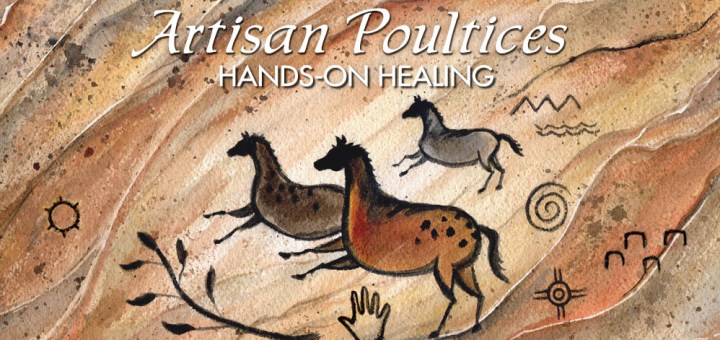
What Makes a Horse Poultice Unique?
There are lots of choices in regards to horse poultice products, but neither the equine nor canine industries have seen anything quite like BioStar’s new Artisan Poultices. I know that’s a pretty astounding statement to make. But before you assume I have been drinking too much of the BioStar Kool-Aid, let me say that this statement comes not from ego and arrogance, but from two years of solid testing, research, experimentation, and study. All this effort has resulted in three very highly unique varieties of therapeutic horse poultice.
They are made by hand, one container at a time. We opted never to blend by machines, or with metal bowls, mixers, or spoons because stainless steel and other metals can reduce the effectiveness of the clays used in the poultices. These poultices have been tested on humans, equines, canines, felines, and even chickens. From the testing it became clear that to treat a variety of health issues: hoof abscesses, hoof bruising, wounds, insect bites, hives, sore muscles, sore joints, inflammation, etc., that one poultice could not do it all.
BioStar’s Artisan Poultices are three different formulations: one for wounds, abrasions, insect bites, tick bites, and hives, one for sore muscles, sore joints, and connective tissue issues, and one for hooves and paws.
The Clays:
Each Artisan horse poultice is made with a variety of clays: kaolin, calcium bentonite, Moroccan red clay, and sea clay. The reason for the variety is because different clays have different adsorbent and absorbent qualities. Adsorbent clays act like a magnet, drawing toxins and impurities to the outside of the clay’s molecular structure. Absorbing clays are the swelling clays that when hydrated, act as a sponge to soak up toxins and impurities.
One of the rarest clays is Moroccan red clay which comes from deep within the Atlas mountains in Eastern Morocco. This clay is used in European health spas because of its high content of silica and magnesium; higher than any other clay. Sea clay, which comes from the Dead Sea, has been used for thousands of years for healing. It was reputed that Cleopatra used Dead Sea mud as part of her skin regime. This unique clay stimulates circulation, providing wonderful support for muscles, soft tissue, and joints alike.
Essential Oils and the Colloidal:
BioStar’s Artisan Poultices are blended with a range of essential oils including holy basil, oregano, calendula, frankincense, myrrh, tea tree, carrot seed, and arnica flower. Each essential oil was carefully chosen for its therapeutic qualities, efficacies, and synergy with the clays. We also included colloidal silver in our wound poultice due to colloidal silver’s anti-bacterial and anti-microbial properties.
Herbs and Salts:
Powdered or bruised herbs have been used for thousands of years as poultices; either alone, or mixed with mud/clay. BioStar’s Artisan Poultices incorporate this ancient practice by using items such as plantain leaf traditionally used for its anti-inflammatory actions, or Pau’ d Arco bark historically used by the Incas for its anti-fungal, anti-bacterial and anti-inflammatory properties.
Epsom and Dead Sea salt have a long history of use for their therapeutic and rejuvenating qualities. Epsom salt contains high levels of magnesium and sulfate which are readily absorbed through the skin. Dead Sea salt contains high levels of calcium, magnesium, chloride, sodium, potassium, and bromide. These salts are effective for drawing abscesses, reducing swelling, and soothing sore muscles and joints.
Pre-Mixed and Dry Poultices:
Biostar’s Artisan Poultices are available pre-mixed, or as dry poultices you mix yourself and re-hydrated with your choice of liquid. The dry poultices once hydrated have a short shelf life of 2-3 weeks because they do not contain a preservative. As long as you don’t hydrate these poultices they have a shelf life of up to a year.
Hydration of the Poultices:
Each BioStar pre-mixed horse poultice is hydrated with distilled water, organic apple cider vinegar, and witch hazel. Distilled water is important because it does not interfere with the adsorption of the clay. Apple cider vinegar and witch hazel have a long history of topical use for bruises and strains. Both acting as astringents, they will ultimately shrink swollen blood vessels which can relieve pressure and pain. For those dry poultices we offer, you can combine any desired mixture of distilled water, apple cider vinegar and/or witch hazel to rehydrate your poultice.
Preserving the Poultices:
Living clays need a preservative once hydrated, because otherwise they can mold within weeks. BioStar chooses to use Borax in a low concentration to prevent the clays from molding. Most every commercial pre-mixed poultices on the market use some sort of preservative for this reason.
Poultice Power:
Once you have used one of Biostar’s Artisan Poultices, you may find that it’s much more than just a unique horse poultice! Our production team uses the Traumera for their human abrasions, blisters, and cuts. My partner Peter puts the Origin-LLM on his sore calf muscles and sore back. He even loves the Traumera for his own bee stings and insect bites. I personally use Hoof and Sole on the pads of my feet when they get sore, and on sore dog paw pads. I also use Traumera on tick bites that both the dog and myself get from time to time. A good friend of mine says Traumera is great for hemorrhoids, while another friend uses the dry Origin-LLM in her bath to soothe sore muscles. Poultices are not just for horse’s legs! And just when I think I can’t find another use, I get to the end of the poultice, add some water, and give it to the plants.
Poultices are one of the oldest medicines on earth, and reconnect us to our healing hands, and healing earth.
* These statements have not been evaluated by the Food and Drug Administration. This information is not intended to diagnose, treat, cure, or prevent any disease.








